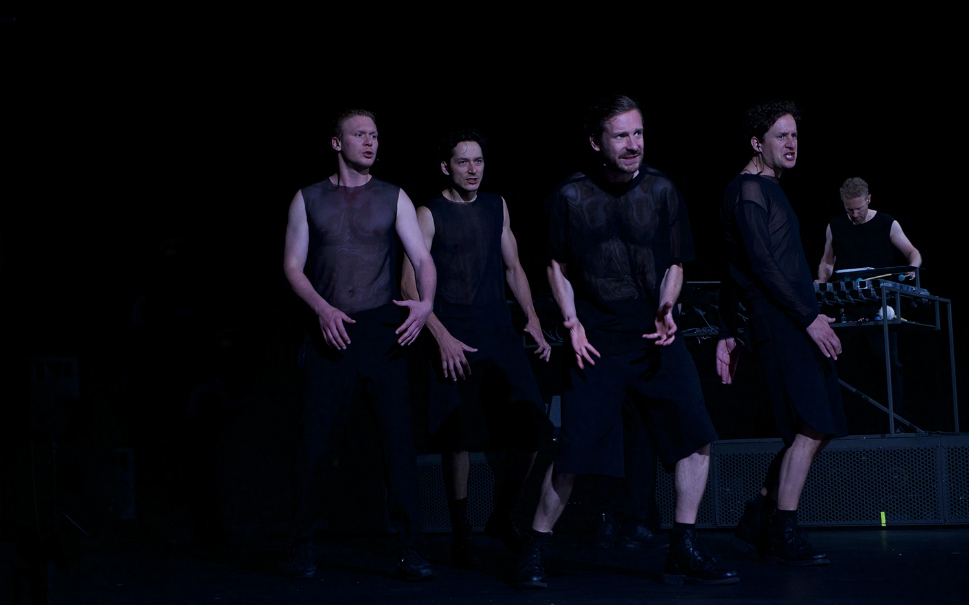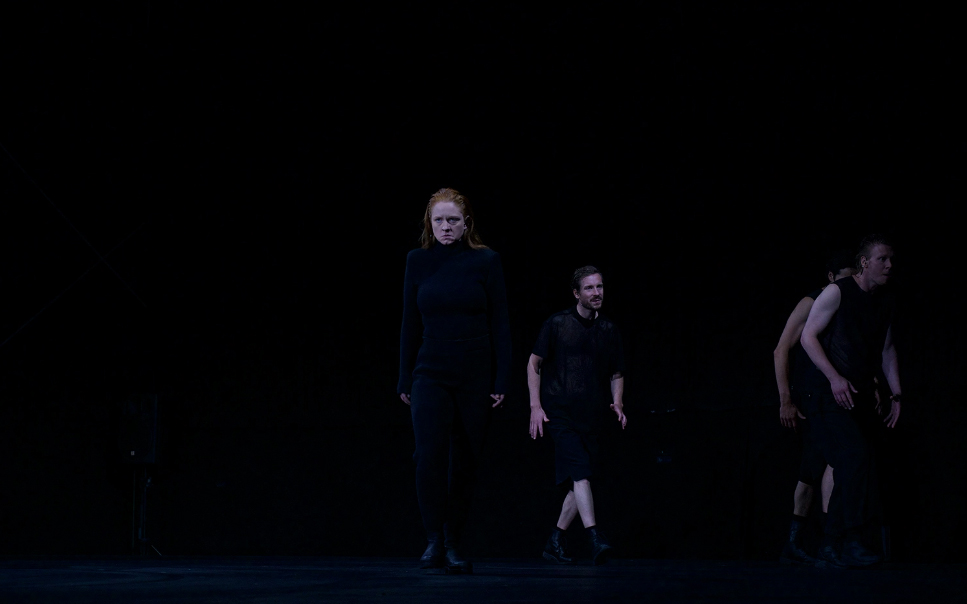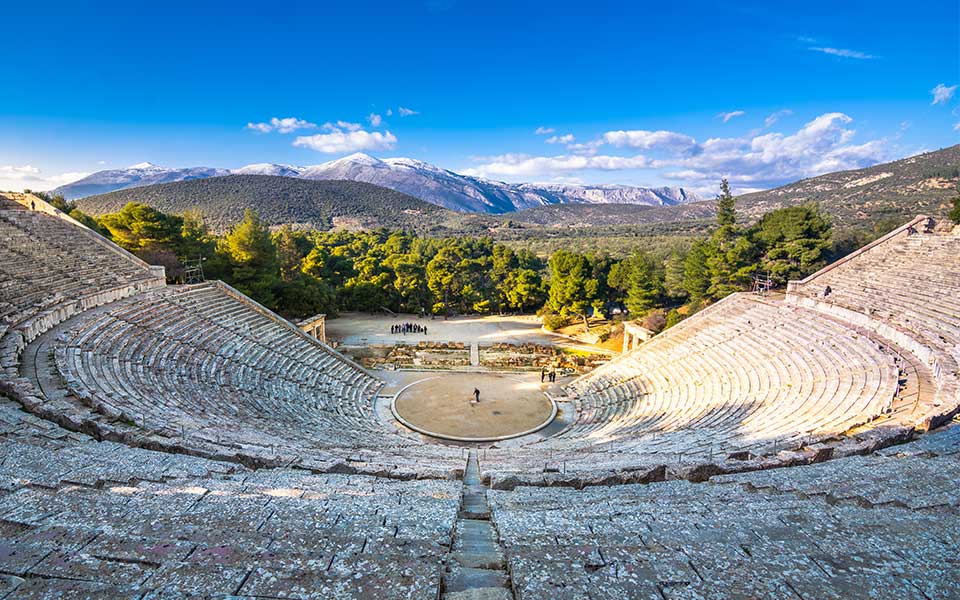He’s drawing on a piece of white paper, showing me how he designed the orchestra at the Ancient Theater of Epidaurus to suit his vision as director. He draws a disc to represent the circular space where the Chorus customarily goes, with a moving hand of sorts above it. “Like a clock,” says Ulrich Rasche. “Four percussionists will go there. The hand will rotate constantly, as will the disc. The rhythm of the music and the clock turning non-stop are key elements of the play.”
I think of the actors trying to keep their balance on this contraption, which will be roughly half a meter above ground. Clytemnestra, Agamemnon, Cassandra, Aegisthus and the Chorus will battle it out in a mechanical version of the palace where Aeschylus set “Agamemnon,” the first part of the ancient Greek playwright’s “Oresteia” trilogy.
“It’s about the perpetual cycle of revenge and counter-revenge, about the unbreakable and unshakable curse on the House of Atreus, cast on its original sinner, Tantalus. They are trapped in a vicious cycle of blood; every drop cast must be met with another bloody offering. For me, the ‘Oresteia’ is a perpetual cycle of murder and revenge, where Aeschylus does not restore order until the third and final part, stressing the importance of institutions and democracy. This clock-like design seeks to convey this descent into violence, into the spiral of crime. There’s a scene in the ‘Oresteia’ where the Chorus says: ‘Now in place of the young men, urns and ashes are carried home.’ The mechanical contraption is a scenic metaphor, a reference to the wars that never end,” says Rasche.

© Nils Hampe
World premiere
He sits across from me dressed in black, organized, with his notes on the show neatly arranged in front of him. The “Agamemnon” he is staging at the ancient theater on July 22 and 23 is a coproduction with Munich’s Residenztheater and one of two world premieres at this year’s Athens and Epidaurus Festival, a production of global proportions that was created especially for this theater.
Rasche is one of the most sought-after contemporary directors right now and a particular favorite among the younger theater audience, thanks to his innovative idiom and style: mechanical props, impressive lighting and loud music are brought together to create a frenetic setting that often evokes an almost maniacal performance from his cast.
His choices for Epidaurus have the wholehearted support of the festival’s artistic director, Katerina Evangelatos.
“When I saw Rasche’s performance for the first time, I was impressed by the way that he channelled the actors’ energy and by the painstaking work that had obviously gone into the text, but I also felt like I was slowly being sucked into a musical, theatrical, choreographic and artistic universe where every element is linked perfectly to each other,” she says.
“His scenic style, with its intense and distinctive artistic bent, the actors being in perpetual motion, the delivery in unison of the text with live music and, most importantly, with love for ancient drama, all conspired to make this international production happen,” adds Evangelatos.

© Nils Hampe
Rasche was born in 1969 in Bochum – a big city in the Ruhr Valley that was famous for its steelworks in the 19th century and today for its soccer team – and has been specializing in ancient Greek theater for almost 15 years. “I have done ‘Oedipus,’ ‘The Bacchae,’ ‘Seven Against Thebes,’ ‘Antigone’ and ‘The Persians.’ There are many reasons why I have chosen to do Greek drama. To begin with, the Chorus, which I believe expresses society by giving voice to our questions. The Chorus is also connected to music and rhythm. But it is the movement I find so interesting, the way it was introduced to the orchestra of the ancient theater. These are elements that appear in many of my performances,” he says.
“Dance, as an activity, is something that I have always found moving, which is why it has such an important part in my plays. There’s a connection between dance and language, and that is precisely the element you find in the Chorus in Greek tragedies,” adds the director, demonstrating his academic qualifications in history of art and comparative literature, but also his childhood passions.
“I was drawn to dance as a youngster and that is what eventually brought me to theater. The city where I was born is just 30 kilometers from Wupperthal, where Pina Bausch worked. I never missed a performance. As I got older, I kept watching dance, and especially the work of other great choreographers like William Forsythe and Jiri Kylian. It was my love for dance that made me ask myself how I could cast the actors in a state of perpetual motion. I thought in choreographic terms, but in order to put on a performance, I had to work with actors, not dancers. And that’s when I came up with the idea of a mechanical platform on the stage, be it a moving walkway or tilting discs. These constructions may convey the impression that I am interested in engineering, but no, it’s motion I’m interested in,” says Rasche.

© Shutterstock
He has been known for stage designs where the movement was so intense, the actors struggled to keep their foothold. “There were even moments when the stage would lunge towards the audience, like, for example, when the maenads attack Pentheus. I used sudden tilts to convey the violence of the acts,” he says. “In ancient tragedy, the Chorus is a group of people often describing violent and barbaric acts. I wanted to convey the violence of their words to the stage. At first I did this with a moving floor, which made the actors lose their balance. But ever since ‘Oedipus,’ which I did last year, I have moved away from the model of big and expensive machinery that covers the entire stage,” explains the director.
For the ancient theater in the northern Peloponnese, the Athens and Epidaurus Festival’s prop builders have built a platform to hold the rotating disc that represents the palace, which is made of wood and metal.
“Looking at the orchestra at Ancient Epidaurus, at the theater’s incredible dimensions, the proportions of the landscape, the tranquility of the overall area, I realized that I could accomplish what I wanted just with the mechanical disc. I think that this production of ‘Agamemnon’ at Epidaurus will mark a turning point in my career but also an incredible challenge for myself and my associates at the festival.”
This article was previously published at ekathimerini.com.












